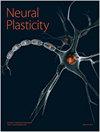腰椎间盘突出症引起的慢性神经根压迫综合征的脑网络改变
IF 3.7
4区 医学
Q2 Medicine
引用次数: 2
摘要
腰椎间盘突出症(LDH)引起的神经压迫综合征一直是一个复杂的神经机制的普遍问题。分布脑区的变化与综合征的发生和持续有关。本研究旨在应用图论分析LDH合并慢性坐骨神经痛患者脑功能网络的变化。共招募了30例LDH成人L4和/或L5根压迫综合征(LDH组)和30例年龄、性别、BMI和教育程度相匹配的健康对照(HC组)进行功能性MRI扫描。采用Pearson相关法对每个参与者构建全脑功能网络。计算并比较两组的全局和节点属性,包括小世界指数、聚类系数、特征路径长度、度中心性(DC)、中间中心性(BC)和节点效率。LDH组和HC组脑功能网络均呈现小世界结构。LDH组显示下额回眼部节中度(DC、BC和节效率)升高;额下回眶部、舌皮层、枕下回均减少。LDH组右枕下回DC和效率与Oswestry失能指数呈负相关。总之,ldl相关的慢性坐骨神经痛综合征可能引起涉及自我参照、情绪反应和疼痛调节功能的大脑区域改变。但是整个大脑的小世界结构并没有受到明显的干扰。这可能从新的角度为LDH患者的神经根症状提供新的认识。本文章由计算机程序翻译,如有差异,请以英文原文为准。
Brain Network Changes in Lumbar Disc Herniation Induced Chronic Nerve Roots Compression Syndromes
Lumbar disc herniation (LDH) induced nerve compression syndromes have been a prevalent problem with complex neural mechanisms. Changes in distributed brain areas are involved in the occurrence and persistence of syndromes. The present study aimed to investigate the changes of brain functional network in LDH patients with chronic sciatica using graph theory analysis. A total of thirty LDH adults presenting L4 and/or L5 root (s) compression syndromes (LDH group) and thirty age-, sex-, BMI- and education-matched healthy control (HC group) were recruited for functional MRI scan. Whole-brain functional network was constructed for each participant using Pearson's correlation. Global and nodal properties were calculated and compared between two groups, including small-worldness index, clustering coefficient, characteristic path length, degree centrality (DC), betweenness centrality (BC) and nodal efficiency. Both LDH and HC groups showed small-world architecture in the functional network of brain. However, LDH group showed that nodal centralities (DC, BC and nodal efficiency) increased in opercular part of inferior frontal gyrus; and decreased in orbital part of inferior frontal gyrus, lingual cortex and inferior occipital gyrus. The DC and efficiency in the right inferior occipital gyrus were negatively related with the Oswestry Disability Index in LDH group. In conclusion, the LDH-related chronic sciatica syndromes may induce regional brain alterations involving self-referential, emotional responses and pain regulation functions. But the whole-brain small-world architecture was not significantly disturbed. It may provide new insights into LDH patients with radicular symptoms from new perspectives.
求助全文
通过发布文献求助,成功后即可免费获取论文全文。
去求助
来源期刊

Neural Plasticity
Neuroscience-Neurology
CiteScore
5.70
自引率
0.00%
发文量
0
审稿时长
1 months
期刊介绍:
Neural Plasticity is an international, interdisciplinary journal dedicated to the publication of articles related to all aspects of neural plasticity, with special emphasis on its functional significance as reflected in behavior and in psychopathology. Neural Plasticity publishes research and review articles from the entire range of relevant disciplines, including basic neuroscience, behavioral neuroscience, cognitive neuroscience, biological psychology, and biological psychiatry.
 求助内容:
求助内容: 应助结果提醒方式:
应助结果提醒方式:


